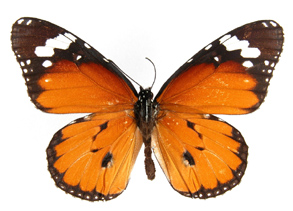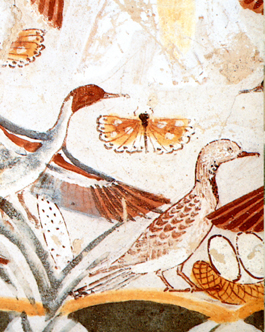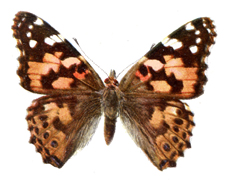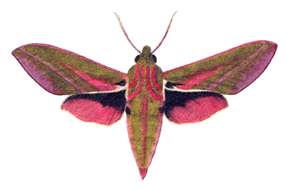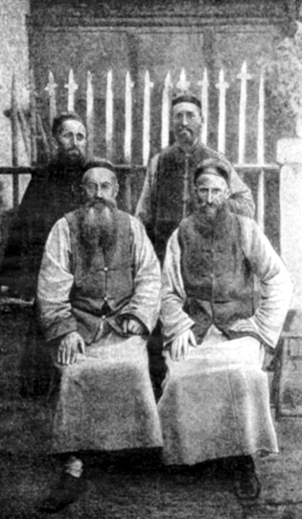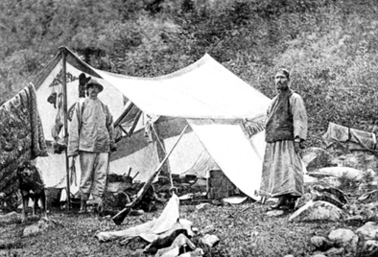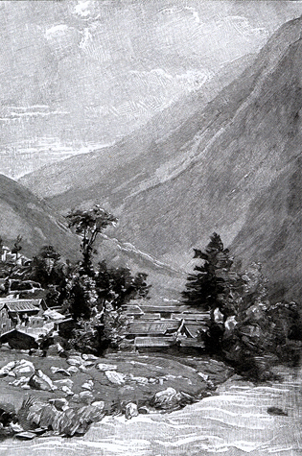Butterflies and Moths in Nabokov's Published Writings
Alphabetical Order ‒ Page 3
Danainae Boisduval, 1833: a subfamily of »Nymphalidae, consisting of some 300 species, most of them tropical and sub-tropical. »Their most prominent member is the Monarch, Danaus plexippus Linnaeus, 1758. Their name comes from Greek mythology; it derives from the fifty daughters of Danaos. Some authors continue to treat the Danainae as a family of their own (Danaidae).
*NabBut 602 (BE)
& Ac: Danaínae • Am: Milkweeds, Tigers • Fr: danaïdés • Ge: Monarchfalter • It: danaidi • Ru: монархи • Sp: danaidos
Danaus Kluk, 1802: a genus of Nymphalidae, subfamily »Danainae. The type-species is »Danaus plexippus, the Monarch.
*NabBut 602 (BE)
Danaus chrysippus Linnaeus, 1758 [Nymphalidae, Danainae]: the Plain Tiger, a wide-ranging migrant butterfly much like the Monarch (»Danaus plexippus), but smaller (the wingspan is c. 70 mm, 25 mm less than that of the Monarch), with transverse white spots on the forewing tips and with the wing venation much less marked. Like those of the Monarch, the caterpillars feed on milkweed (Asclepias), and for this reason the butterfly is as poisonous to birds. Its range is Canary Islands, all of Africa (from where it sporadically visits the N shores of the Mediterranean), Arabia, India, SE Asia, Indonesia, Australia.
In his research for a book on butterflies in art, Nabokov came across a very special Plain Tiger: "This butterfly has the distinction of being the oldest known to have been represented by man. Seven specimens of it (with a typical white-dotted Danaus body but somewhat »Vanessa cardui like wingtips) are shown flitting over the papyrus swamp in a fowling scene from a Theban tomb (XVIII Dynasty. 1580–1350 BC), Brit.Mus." About Alice Ford's edition of Audubon's butterfly drawings, he wrote, "She [Ford] might have traveled back some thirty-three centuries to the times of Tuthmosis IV or Amenophis III and, instead of the obvious scarab, found there frescoes with a marvelous Egyptian butterfly (subtly combining the pattern of our Painted Lady and the body of an African ally of the Monarch)."
The butterflies Nabokov was speaking of are on one of the murals in the Tomb of Nakht, a scribe and official at the temples of Karnak, in the necropolis of Thebes-West. The mural is known as "Hunt in the Papyrus Swamp" and believed to have been painted during the reign of Thutmosis IV (1402–1392 BC), 18th Dynasty. The butterflies fly among eleven birds of several species and are flanked by two large hunters and seven smaller persons. Behind and underneath them there is a green wall of papyrus. In the foreground there is blue water with a "mountain" of fishes. The tomb was opened in 1889 and is still in place (and not at the British Museum). Between 1907 and 1910, all its wall paintings were carefully copied by the British egyptologist Norman de Garies Davis and his wife Nina for the New York Metropolitan Museum of Art which subsequently published them and made them famous.
*NabBut 489, 603 (BE), LtVé 478
& Ac: Danáus chrysíppus • En: Plain Tiger • Fr: le petit monarque • Ge: Kleiner Monarch
|
The Little Monarch (Danaus chrysippus). From the National Taiwan University Insect Museum Digital Archives |
Butterflies in the Tomb of Nakht, Thebes-West (see also "»Butterflies in Art" |
|
|
|
|
Vanessa cardui (Lampert 1907) |
|
|
|
The Monarch, Danaus plexippus (Staněk 1977)
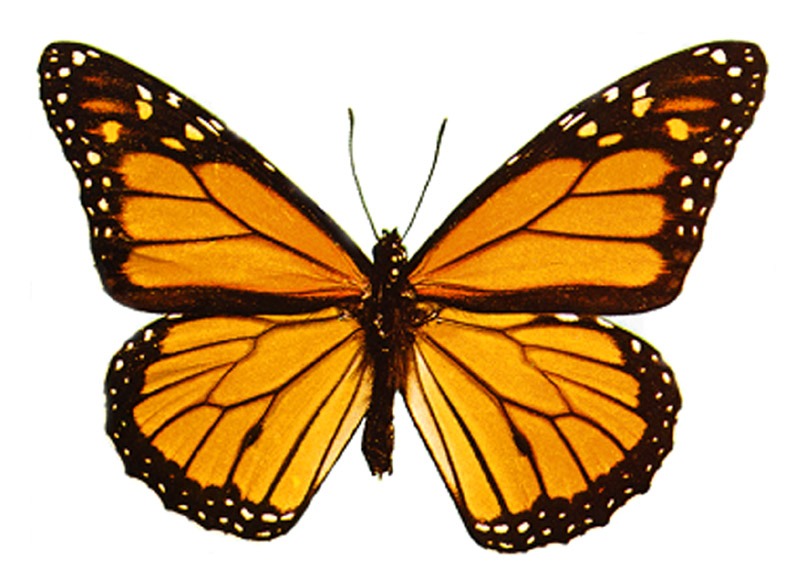
Danaus plexippus Linnaeus, 1758 [Nymphalidae, Danainae]: the Monarch, America's most famous butterfly. It is specially known for its extraordinary migratory capabilities. The large (wingspan 89–102 mm) and black-and-amber Monarch originally is strictly N American, flying in the region of the Great Lakes and migrating each fall in flocks of millions to the highlands of C Mexico (especially to the reserve El Rosario in the Sierra Madre). There the Monarchs hibernate in semi-torpor tightly packed on Oyamel trees, a Mexican species of firs. How they manage to find their way is still a mystery. The butterflies returning each year to the very same overwintering sites are not the ones who left them earlier that year but their descendants, removed by one or two generations, and thus had no prior experience. The Monarch is one of the fastest of all butterflies (up to 40 kmh) and believed to be able to cross the oceans. Around 1840 it was first observed in New Zealand, around 1870 in Australia, around 1880 on the Canary Islands, and today it is taking hold in S Spain and establishing colonies in other Mediterranean countries; sometimes it may even be observed in France, England and Ireland.
Monarch caterpillars feed on Milkweed (mainly Asclepias curassavica), some species of which contain cardiac glycosides. The adult butterflies that contain them are toxic to birds. In small dose, they make them vomit violently, in large (about double) dose they are lethal. Nabokov told one interviewer that he once ate Monarchs and Viceroys: "The taste of both was vile, but I had no ill effects. They tasted like almonds and perhaps a green cheese combination."
*StrOps 331; Pnin 136; Ada 158; Int1 130; SelLet 113; NabBut 398 (L), 485 (L), 487 (L)
& Ac: Dánaus plexíppus • En: Monarch, Milkweed, Wanderer • Fr: le monarque, (Ada) la Danaïde Monarque • Ge: Monarch • It: monarca • Ru: (бабочка) монарх • Sp: monarca
Danaus sylvia: "the Sylvia Danaus", an imaginary milkweed butterfly Nabokov drew in 1947 for his Wellesley College colleague, the short-story writer Sylvia Berkman, on the front flyleaf of Bend Sinister.
*NabBut plate 17
Daphnis Hübner, 1819: a genus of »Sphingidae (hawk moths), subfamily Macroglossinae. The type-species is »Daphnis nerii, the Oleander Hawk.
Daphnis nerii (Procházka 1966)
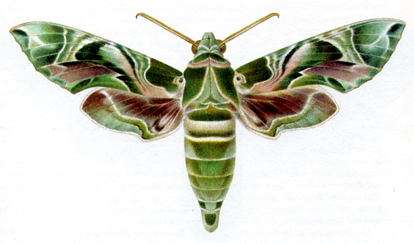
Daphnis nerii Linnaeus, 1758 [Sphingidae]: a large hawk moth (wingspan 90–130 mm) with green, yellow and brownish marbled forewings at home where oleander grows, the foodplant of its caterpillar: in Africa, S Europe, Asia Minor, India.
*Stor:Aur 250; Lep1 33; LtVé 51
& Ac: Dáphnis nérii • En: Oleander Hawk • Fr: le sphinx du laurier-rose • Ge: Oleanderschwärmer • It: sfinge dell'oleandro • Ru: бражник олеандровый • Sp: esfinge de la adelfa
Death's Head Moth: »Acherontia atropos
Deilephila Laspeyres, 1809: a genus of Sphingidae (hawk moths), subfamily Macroglossinae. The type-species is »Deilephila elpenor, the Elephant Hawk Moth.
Deilephila elpenor and its caterpillar (Sepp 1762)
|
|
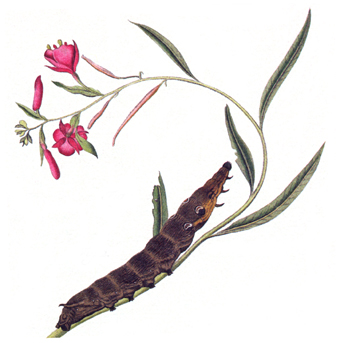 |
Deilephila elpenor Linnaeus, 1758 [Sphingidae]: an olive and pink hawk moth (wingspan 60–68 mm) flying in the May and June dusk from flower to flower (phlox), hovering over it hummingbird-like and sucking nectar with its long proboscis. Its preferred habitat are riparian forests, river banks and lowlands, but also the parks and gardens of cities. Its range is Europe except for the northernmost parts, Asia Minor, C Asia and Japan.
The Elephant Hawk Moth owes its English common name to its green, brown or frequently almost black caterpillar, "naked" and tapering towards the head which gives it the semblance of an elephant trunk, an impression accentuated by two eyespots on each side of the thorax. When threatened, the larva puffs out the ocellated thorax, raises it and thrushes about. That seems to make an effective snake scare. In his book on mimicry, Arnold Jacobi (1913) reports that the caterpillar of the Elephant Hawk Moth has been observed to chase sparrows and chicken away. Its time is June to August, and its preferred foodplant is willow herb (Epilobium angustifolium) and cleavers (Galium).
In The Gift (p. 137) there are "the pink hawks sampling our lilacs," at Leshino, S of St. Petersburg. Though there are several species in that region that have some pink, the most likely candidate is the Elephant Hawk Moth, as it is known to sample lilacs and other sweet smelling flowers and as its American common name is just that: Pink Hawk.
In Speak, Memory, Nabokov fondly remembers the hawk moths, "the jets of my boyhood," and particularly one: "A moist young moon hung above the mist of a neighboring meadow. In many a garden have I stood thus in later years – in Athens, Antibes, Atlanta – but never have I waited with such a keen desire as before those darkening lilacs. And suddenly it would come, the low buzz passing from flower to flower, the vibrational halo around the streamlined body of an olive and pink Hummingbird moth poised in the air above the corolla into which it had dipped its long tongue. Its handsome black larva (resembling a diminutive cobra when it puffed out its ocellated front segments) could be found on dank willow herb two months later."
*Gift 137; SpeakM 134–5
& Ac: Deiléphila elpénor • Am: Pink Hawk • En: Elephant Hawk Moth • Fr: le moyen sphinx de la vigne • Ge: Mittlerer Weinschwärmer • Ru: бражник Эльпенор, винный бражник • Sp: esfinge de la vid
Deilephila euphorbiae: »Hyles euphorbiae
Deilephila livornica: »Hyles lineata livornica
Delias Hübner, 1819: a genus of »Pieridae, subfamily Pierinae (whites), mostly in SE Asia. The type-species is Delias pasithoe Linnaeus, 1767, syn egialea Cramer, 1777, the Red-Base Jezebel. Nabokov considered Aporia a subgenus of Delias.
*NabBut 587 (BE)
Dia: »Clossiana dia
Diana: »Speyeria diana
Dianthœcia Boisduval, 1834: an obsolete genus of »Noctuidae, subfamily Noctuinae; the name is one of at least sixteen synonyms of the genus Hadena Schrank, 1802.
*Lep2 257
Dicranura (ex Exereta, not Exaeretia) ulmi Denis & Schiffermüller, 1775 [Notodontidae]: a prominent moth, in S and C Europe, Asia Minor, Urals and Caucasus.
*Lep2 257
Didymaeformia (ex Melitaea) didyma Esper, 1779 [Nymphalidae, Nymphalinae, Melitaeini]: a widespread and common checkerspot, from NW Africa, S and C Europe, Russia, Middle East to Afghanistan, N Pakistan, Kazakhstan, Mongolia, W China. "The ridiculous number of subspecific names!"
One of them is Didymaeformia didyma aabaca Fruhstorfer, 1917 which Nabokov considered a subspecies of »Didymaeformia trivia.
*NabBut 580 (BE), 600 (BE); Lep1 31
& En: Spotted Fritillary • Fr: la mélitée orangée • Ge: Roter Scheckenfalter • Ru: шашечница кразная
Didymaeformia (ex Melitaea) trivia Denis & Schiffermüller, 1775 [Nymphalidae, Nymphalinae, Melitaeini]: the Lesser Spotted Fritillary, in N Spain, Italy, Balkans, S Russia, Asia Minor, Middle East, Kazakhstan, Afghanistan, N Pakistan, N India.
Nabokov says the subspecies catananoides Verity, 1918 is "hardly a ssp., merely a dwarfish form of the second generation, which can be exactly duplicated in other localities. The forms nana Staudinger 1871 [described by Staudinger as a 'var & ab'] from S Turkey and [var.] catapelia Staudinger 1886 from the vicinity of Samarkand, belong here," that is they are no true subspecies either. The name aabaca FRUHSTORFER (today considered a subspecies of »Didymaeformia didyma), he said, "should do, despite its ugliness, for the Iberian subspecies, including ignasiti Sagaria [= de Sagarra] (1926) from Catalonia and microignasiti Verity (1950) from Portugal … Dismiss – but figure Spanish specimens".
*NabBut 600 (BE)
Dira Hübner, 1819: a S African genus of »Satyrinae, tribe Dirini. The type-species is Dira clytus Linnaeus, 1764, in S Africa.
*NabBut 594 (BE)
Discestra (ex Trichoclea) sociabilis de Graslin, 1850 [Noctuidae, Noctuinae]: an owlet moth of S Europe.
*Lep2 257
Drasteria (ex Leucanitis) cailino (not caylino) Lefèbvre 1827 [Noctuidae, Catocalinae]: an owlet moth whose forewings are marbled dark brown, light brown and gray; the hindwings have the same browns, but white instead of gray. The wingspan is c. 40 mm. It flies in S and SE Europe. Nabokov called it "beautiful".
*Lep2 268
Driopa mnemosyne (Lampert 1907)
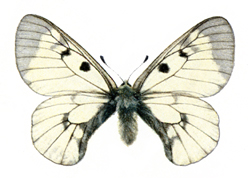
Driopa (ex Parnassius) mnemosyne Linnaeus, 1758 [Papilionidae]: one of the three European parnassians (the other two are in the genus »Parnassius), found all over Europe north of the Pyrenees except Britain, generally at elevations between 1,000 and 1,700 m. It lacks the red eyespots of the other two European parnassians and is purely black and white. It is also smaller (wingspan c. 58 mm).
This is the butterfly drawn by Nabokov for the map of Vyra and the neighboring estates in Speak, Memory and for the jacket of the Weidenfeld edition. Mnemosyne, to be sure, in Greek mythology was the Goddess of Memory and the mother of the nine Muses. At one time, Nabokov had wanted to call his memoirs Speak, Mnemosyne!, abandoning it only because it is so hard to pronounce. Note that the Clouded Apollo is not a symbol of memory; its connection to memory is merely through the chance name Linné bestowed on it.
*Gift 98; SpeakM 17, 210; SelLet 118, 436; NabBut 623 (L); LtVé 502
& Ac: Driópa/ Parnássius mnemósyne • En: Clouded Apollo, Black Apollo • Fr: le semi-apollon, Mnémosyne • Ge: Schwarzer Apollo • It: mnemosine • Ru: парусник Мнемосина, черный Аполлон • Sp: blanca de asso
Driopa (ex Parnassius) mnemosyne var. pyrenaica Turati, 1908 [Papilionidae]: the paper Nabokov published on his collecting trip to the Pyrenees and the Ariège in 1931 makes no mention of the author of this subspecies, taken on June 16, 1929 in the Chemin de Lanes near Saurat in the vicinity of Tarascon. But Nabokov will have become aware of the author when he identified his catch either on the spot or upon his return to Berlin. As during that time he was working on his novel The Defense, it is possible that Luzhin's adversary, the Italian chessplayer Turati, was named after the author of this form of the Black Apollo. When Nabokov found that the subspecies he had taken had already been described by someone else, he may have thought of him as a sort of rival. Count Emilio »Turati of Gardone on Lake Garda (where Nabokov much later wrote parts of Ada and went butterfly hunting) was a specialist in the systematics of Italian and N African butterflies.
*Lep2 270
Dryas paphia: »Argynnis paphia
dusky-wing skipper: »Erynnis
dusky-winged: »Clossiana improba
Dyspessa (ex Endagria) salicicola Eversmann, 1848 [Cossidae]: a carpenterworm moth in S Russia.
*Lep1 33
Echinargus Nabokov, 1945: a genus of »Lycaenidae introduced by Nabokov (subfamily Polyommatinae, tribe Polyommatini, Nabokovia Section). See in »Section 1.1. Nabokov emphasized that Echinargus belongs to the group of blues he called »Plebejinae.
*StrOps 327; NabBut 496 (L); Lep9 27–31 passim
Echinargus huntingtoni Rindge & Comstock, 1953 [Lycaenidae]: a species of Neotropical polyommatines collected by E.I. Huntington in Trinidad, named by F.A. Rindge and W.P. Comstock of the American Museum of Natural History and assigned by Nabokov to his new genus »Echinargus prior to the OD.
*SelLet 480; Lep9 27
Echinargus isola (Howe 1975)

Echinargus (ex Hemiargus, Lycaena) isola Reakirt, 1866 [Lycaenidae]: Reakirt's (Eyed) Blue (or Mexican Blue), one of the blues of the Nabokovia Section and the type-species of Nabokov's new genus Echinargus (see in »Section 1.1), from Colombia to Mexico and SW United States. "Bethune Baker's assigning isola to Hemiargus was a blunder."
*StrOps 320, 327, 328; SelLet 56; NabBut 496 (L); Lep9 28–29
Echinargus (ex Lycaena) martha Dognin, 1887 [Lycaenidae]: a polyommatine from Peru and Bolivia that Nabokov examined in 1945 and found to belong to his new genus Echinargus (see in »Section 1.1).
*StrOps 327; SelLet 55–56; Lep10
Echo Azure: »Celastrina ladon echo
Edda Ringlet: »Erebia edda
Edusa Gold: 'Edusa' is one of Nabokov's cryptic butterflies, hidden in a name. The lady would seem to be named after the Eastern Bath White (»Pontia edusa Fabricius, 1777) if it were not for her surname, Gold. Pontia edusa is not at all golden but white, with dark markings. So her name might rather be a reference to an obsolete name of the Clouded Yellow (»Colias crocea Fourcroy, 1785). Fabricius in 1787 had called it edusa, perhaps forgetting that he had used the same name ten years before for the Eastern Bath White. In the butterfly books of the turn of the 19th century, the Clouded Yellow generally figures as Colias edusa.
*Lol 209
Egeria: »Pararge aegeria
Electra Gold: a "marvelous young [tennis] coach". According to Appel's Annotated Lolita (p. 417), Nabokov wanted to refer to "a close ally of the Clouded Yellow butterfly" which had given rise to the name of her sister Edusa Gold, »Colias crocea. There are about a dozen Lepidoptera by the name of electra, but there is no pierid among them. Zsolt Bálint suggests that the ally is Colias electo Linnaeus, 1763, the African Clouded Yellow.
*Lol 231
Elphinstone: the name of the town (in Arizona, according to Lolita: A Screenplay, p. 169) where Quilty takes Lolita from H.H. Various non-butterfly sources for the name have been suggested (eg VNRN, 3, Fall 1979, p. 29; VNRN 5, Fall 1980, p. 26). There exists a further possibility: a pierid genus by the name Elphinstonia. It was first introduced by Alexander B. »Klots, then of Ithaca, New York ("A Generic Revision of the Euchloini", Bulletin of the Brooklyn Entomological Society [New York], 25, April 1930, p. 80–95) who unfortunately does not say whom the name was meant to honor. Klots's Elphinstonia has since reverted to Euchloe Hübner, 1819. The type-species was to be Elphinstonia charlonia Donzal, 1842, a yellow Orange-tip of NW Africa which is a close ally of the »Zegris butterfly of Ada. The butterfly allusion is not necessarily implied.
*Lol 31, 222, etc.
Elwes' Swallowtail: »Papilio elwesi
Emesis (ex Lemonias) zela Butler, 1870 [Lycaenidae, Riodininae]: the Arizona Metalmark. "The form of its wings and its general manner are very mothlike. Quite interesting. But it is a real butterfly. It belongs to a tremendous family of South American butterflies."
*Int1 128
Emperor Moth: »Saturnia pavonia
Endagria salicicola: »Dyspessa salicicola
Enodia dryas: »Minois dryas
Enodia portlandia Fabricius, 1781 [Nymphalidae, Satyrinae, Parargini]: the Pearly Eye, from Maine to Manitoba and south to the Gulf States.
*NabBut 398 (L)
Epargyreus clarus Cramer, 1775 [Hesperiidae, Pyrginae]: the Silver-spotted Skipper, from Quebec to British Columbia and south to Florida, Texas and Baja California.
*StrOps 327; Int1 126 (NabBut 531)
Epargyreus clarus clarus Cramer, 1775, syn tityrus Fabricius, 1775 [Hesperiidae]: the nominate subspecies of the Silver-spotted Skipper, in urban and suburban habitats of N America.
*NabBut 398 (L)
Epichnopteryx pulla Esper, 1785 [Psychidae]: "I also took three examples of another Psychid, similar to some small specimens labeled 'pulla,' from Barcelona, in the Püngeler Collection. It flew, a minute black speck, over stones and heather on the hill just behind the hotel between two and four o'clock" (in the spring of 1929, in the Eastern Pyrenees).
*Lep2 257
Epicnaptera moth: »Phyllodesma japonica arborea
Epidemia (ex Lycaena) mariposa Reakirt, 1866 [Lycaenidae, Lycaeninae]: the Mariposa Copper (or Reakirt's Copper), locally in Alaska, British Columbia, Colorado, Idaho and N California.
*Lep16
Epinephele jurtina: »Maniola jurtina
Epinephele lycaon: »Hyponephele lycaon
Erebia Dalman, 1816: a genus of »Nymphalidae, subfamily Satyrinae, tribe Erebiini (US alpines, GB ringlets and arguses). The type-species is »Erebia ligea, the Arran Brown. The genus "reaches its great development in Europe – especially in the mountains of Europe". The Erebias (called Arguses in Great Britain) are highly typical of sunny meadows in the Alps, usually showing up in multitudes, sauntering leisurely and low near the grass and going into hiding as soon as the sun disappears even for a moment. There is a bewildering number of species – about eighty, from yellow to orange to fuscous to downright black, varying with geographical direction and altitude.
In "The Butterflies of Europe," Nabokov meant to propose a new arrangement on the basis of their genitalia. It was to consist of 14 species-groups –
1– ligea species-group (genus Erebia, with »ligea, euryale, »eriphyle, »manto, claudina, »flavofasciata, »christi, pharte, »epiphron, melampus, sudetica, serotina)
2– medusa species-group (former genus »Medusia, with medusa, »triaria, rossi)
3– fasciata species-group (with fasciata)
4– edda species-group (with »edda)
5– alberganus species-group (former genus »Gorgo, with alberganus, dabanensis)
6– epistygne species-group (former genus »Phorcis, with »epistygne, »pluto, »gorge, gorgone, »rhodopensis, aethiopella, »mnestra)
7– tyndarus species-group (with tyndarus, hispania, »cassioides, ottomana, »pandrose)
8– pronoe species-group (former genus »Syngea, with »pronoe, lefebvrei, scipio, styrius, styx, montanus, neoridas, zapateri, melas
9– meolans species-group (former genus »Marica, with »meolans, palarica)
10– oeme species-group (with oeme)
11– aethiops species-group (former genus »Truncaefalcia, with »aethiops)
12– embla species-group (with »embla, »disa, cyclopius)
13– "»Atramentaria", a group consisting of one species
14– the genus »Callerebia
*NabBut 230 (FB), 590–91 (BE)
Erebia (ex Truncaefalcia) aethiops Esper, 1777 [Nymphalidae, Satyrinae]: the Scotch Argus, in Scotland and NW England, C and E Europe, N Turkey, Transcaucasia, Urals, Altai, W Siberia, from 300–2,000 m, mostly below 1,500.
The subspecies altivaga Fruhstorfer, 1917, says Nabokov, is "an altitudinal form, rather than a subspecies, occurring at high elevation throughout the central Alps. Eggs brought down from 2,500m to 250m would probably produce individuals belonging to ssp. sapaudia or rubria or aethiops." It has since been synonymized under aethiops.
*NabBut 590 (BE), 593 (BE)
& Ac: Erébia áethiops • En: Scotch Argus • Fr: le moiré sylvicole • Ge: Waldteufel • Ru: чернушка Ефиопка
Erebia afra: »Proterebia afra
Erebia callias callias W.H. Edwards, 1871 [Nymphalidae, Satyrinae]: the Relict Gray Alpine or Colorado Alpine, in the Rocky Mountain States of N America and in Asia.
*StrOps 323
Erebia christi Rätzer, 1890 [Nymphalidae, Satyrinae]: in his tv interview with Peter Duval Smith (BBC "Bookstand"), filmed July, 1962 in Zermatt, broadcast Nov 4, 1992, and printed in Speak, Memory, Nabokov, backed by the Matterhorn in full splendor, suddenly interrupts his answer, glances aside, and when the interviewer asks him what is the matter, he remarks, "Oh, I thought for a moment it was an Erebia christi, but that doesn't occur here but in the Laggintal". What he did not say was that a few days before he had gone to the Laggintal and actually taken a specimen which is preserved at the Lausanne Zoological Museum. Erebia christi is a rare alpine ringlet (wingspan c. 33 mm) of which only a few isolated colonies survive, mainly in the Laggintal, S Simplon region, Switzerland, so it would make any butterfly collector turn his head. On the wing it can be easily confused with »Erebia epiphron Knoch, 1783.
"The type locality is a narrow valley, with a beautiful waterfall at its head, on the west side of the Simplon highway just below Simplondorf. In late June or early July, walking up the trail along the north bank of the torrent one may see as low as 1350 m. the males dribble down the southfacing steep slopes, flying low over grass and scree and often settling on flowers. Christi also occurs at a number of other points between 1500m and 2000 m on the southern side of the Simplon, between Laquintal and the Pass …" (from the notes for "The Butterflies of Europe", 1963).
*Int13 61; NabBut 590 (BE), 591 (BE)
& Ac: Erébia chrísti • En: Raetzer's Ringlet • Fr: le moiré du Simplon • Ge: *Rätzers Mohrenfalter
Erebia cassioides Hohenwarth, 1793 [Nymphalidae, Satyrinae]: the Common Brassy Ringlet, locally in N Spain, Alps, Apennines, Macedonia, Albania, Bulgaria, from 1,600–2,600 m. The form murina Reverdin, 1909 was described from Moléson Mt. just north of Montreux.
*NabBut 590 (BE), 591 (BE)
Erebia disa subarctica, m. (Howe 1975)
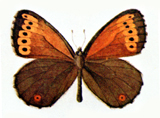
Erebia disa Thunberg, 1791 [Nymphalidae, Satyrinae]: a circumpolar ringlet, flying in spruce bogs and taiga forests of N Europe (Lapland), N Asia and N America (especially Alaska), from 300–500 m. The wingspan is c. 40 mm. Males and females are similar.
In the index of Pale Fire, there is "Disa, Duchess of Payn, of Great Payn and Mone; my [Kinbote's] lovely, pale, melancholy Queen, haunting my dreams, and haunted by dreams of me …" The name certainly is a reference to Erebia disa; the next entry in the index is "Embla", another northern Erebia very close to disa (»Erebia embla) also named by Thunberg. 'Disa' is one of Nabokov's cryptic butterflies, hidden in a name. As to the etymology of disa, Hofmann gives "Disa, daughter of Pluto," the god of Greek mythology who ruled the underworld, perhaps prompted by the fact that Pluto's other names are Hades and Dis. However, Pluto and his wife Persephone had no children; in fact, there seems to be no Disa in all of Greek and Roman mythology. It is more likely that the name is taken from local Swedish lore. Swedish entomologist Carl Peter Thunberg (1743–1828) who bestowed Nordic names on several boreal butterfly species (embla, freija, frigga, lappona, norna) and who was Carl von Linné's successor as Professor of Natural History at the university of Uppsala used the name of an Uppsala celebrity, Disa the clever maiden who won her king's hand in marriage for giving him a piece of advice. Frej, a legendary Uppsala king, had regretfully decided during a famine to save his people from starvation by having the sick and the old killed. Disa (short for Desideria), the daughter of a town councillor in near-by Venngarn, suggested he rather send them off to settle in the uninhabited north of Scandinavia (which was another, albeit perhaps kinder way of putting them to death). It was on her fate that the Protestant pamphletist and Uppsala professor of law, Johannes Messenius, wrote the first Swedish play (Disa, 1611). It was performed by Uppsala students during the market revels in that town.
When exiled King Charles of Zembla visits his spurned wife Disa in her Villa (Para)Disa on Cap Turc, Fleur de Fyler, her lady in waiting, "turned to go with the Disa orchids" (p. 213). These are not just "Disa's orchids". They are the "flowers-of-the-gods" Charles had brought her (p. 206) in tribute to her name. "Flower-of-the-Gods" is an orchid species, Disa uniflora Bergius, 1767 syn grandiflora, from Cape Province, South Africa. The flowers are large (c. 10 cm) and usually red, but there are also yellow and orange ones. The S and E African genus Disa has some 125 species and is very popular with orchid cultivators. The generic name has also puzzled orchid lovers. The explanation is that the Swedish botanist, Peter Jonas Bergius (1730-1790), had also studied with Linné at Uppsala and probably chose the generic name Disa for the same reason Thunberg did, in memory of a legendary Uppsala queen.
"… as alert as a Dira" seems to point to the S African satyrine genus Dira Hübner, 1819. As this is an alien in an enumeration of European Erebias, 'Dira' might be a misprint for 'disa'.
*PaleF 306; NabBut 313 (L), 591 (BE), 592 (BE)
& Ac: Erébia dísa • Am: Disa Alpine, Spruce Bog Alpine • En: Arctic Ringlet • Fr: le moiré boréal
Erebia edda Ménétriès, 1851 [Nymphalidae, Satyrinae]: a ringlet in the Urals, Altai, S Siberia, Ussuri, Mongolia, N Korea.
*StrOps 331; NabBut 590 (BE)
& Ac: Erébia édda • En: Edda Ringlet • Ge: *Edda-Mohrenfalter
Erebia embla (Hofmann 1894)
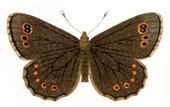
Erebia embla Thunberg, 1791 [Nymphalidae, Satyrinae]: the Lapland Ringlet, in NE Europe, NW Russia, Urals and across Siberia and Mongolia to Kamchatka, Sakhalin and N Korea, from 100–400 m. The wingspan is c. 40 mm. Males and females are similar. "In Europe only in N. Scandinavia and N. Russia, S. to about 60°. In ten years (1907–1917) of assiduous collecting near Leningrad I found only two males and one female, all three in late June, flying singly in birchwood clearings between Rozhestveno and Batovo …"
In the index of Pale Fire, there is "Embla, a small town with a wooden church surrounded by sphagnum bogs at the saddest, loneliest, northmost point of the misty peninsula". The name certainly is a reference to Erebia embla; the preceding entry in the index is "Disa", another northern Erebia very close to embla (»Erebia disa). 'Embla' is one of Nabokov's cryptic butterflies, hidden in a place name. In Norse mythology, Embla was the first woman, created from a tree trunk found on the seashore by three gods, Odin and his brothers Vili and Ve. The first man was Askr. Askr and Embla were the parents of the human race, Adam and Eve of the North.
*PaleF 306; NabBut 591 (BE), 593 (BE)
Erebia epiphron epiphron Knoch, 1783 [Nymphalidae, Satyrinae]: the nominate subspecies of the Mountain Ringlet, described from Brocken Mtn. in the Harz Mountains, Germany.
*NabBut 590 (BE); Lep2 270
Erebia (ex Phorcis) epistygne Hübner, 1824 [Nymphalidae, Satyrinae]: the Spring Ringlet, locally in NE Spain and SE France, from 450–1,500 m.
*NabBut 590 (BE)
Erebia eriphyle (Seitz 1909)

Erebia eriphyle Freyer, 1839 [Nymphalidae, Satyrinae]: one of the rarer ringlets of the C European Alps, from 1,400–2,100 m. This is the last butterfly Nabokov captured in his life, at seventy-six, on July 26, 1975, near Davos, Switzerland.
The first one had been a European swallowtail (»Papilio machaon) the family's janitor had captured for him in the summer of 1906 opposite the main entrance of their mansion at Vyra. Not killed by Mademoiselle's naphthalene, it had been imprisoned in a wardrobe for a night and in the morning escaped through a window.
During his stay in Davos in the summer of 1975, Nabokov only took two species, judging by the Catalogue of Nabokov's last collection that Michel Sartori at the Musée cantonal de Zoologie in Lausanne prepared (in Les papillons de Nabokov, Lausanne 1993). They were one of his blues, »Polyommatus coridon, the Chalk-hill Blue, and Erebia eriphyle, the Eriphyle Ringlet. The last blue was on July 20, the last ringlet on July 26. Arriving in Davos at the end of June, Nabokov was in for a few days of blues only. Then around July 8 he suffered an accident. Brian Boyd (VNAY, p. 652) tells what happened: "… he was climbing at 1,900 metres when he fell painfully down a steep, slippery slope. His butterfly net slid still further to become wedged on the branch of a fir. Climbing after his net he suffered a second, even more painful fall and could not get up. He laughed at his predicament … and waited for the cablecar to glide overhead. Seeing him laughing as well as waving, those on board assumed there was nothing wrong. Only when the cablecar operator noticed the tanned old man in shorts still in the same spot as they skimmed past again did he realize he needed help, and at the end of his run sent two men down to carry Nabokov out on a stretcher. He had had to wait two and a half hours between his fall and his rescue. He had not broken any bones, but had to spend several days in bed. Although by the end of the month he was out chasing butterflies again with another net … some of those close to him thought he never seemed quite the same after his fall." On July 14, Nabokov was up on the slopes again, capturing the first in a series of Erebia eriphyle. On August 20, he wrote to Glenn Collins of the New York Times Sunday Magazine, canceling the "ultimate interview" they had planned: "For more than a month I hunted butterflies at Davos. Then I took a bad tumble down a slippery slope and was laid up for several days … my butterfly net remains hanging on the branch of a fir at 1900 metres like Ovid's lyre." He was never to resume his field excursions.
*NabBut 590 (BE)
& Ac: Erébia eríphyle • En: Eriphyle Ringlet • Fr: le moiré bavarois/savoyard, le petit nègre autrichien • Ge: Ähnlicher Mohrenfalter
Erebia evias: »Erebia triaria
Erebia flavofasciata (Ulster Museum specimen, Wikipedia)

Erebia flavofasciata Heyne, 1895 [Nymphalidae, Satyrinae], a small ringlet of the High Alps of S Switzerland, flying on rocky mountain meadows above 2,000 m, wingspan c. 32 mm. It is chocolate brown, with reddish submarginal bands dotted with little black eyespots like in most Erebias; on the underside of the hindwings, however, these bands are yellow. "… what I see first of all and above all [when thinking of Alp Grüm] is the Yellow-banded Ringlet settled with folded wings on the flower that those damned scythes are about to behead."
In the drafts for "The Butterflies of Europe", Nabokov noted: "The first specimen was taken in July 1893 on that romantic pass [Campolungo] by a German lieutenant colonel a certain von Nolte, a mysterious traveller whom as a child I envied and venerated with poignant unforgettable force." Nabokov must have seen the OD in Die palaearktischen Grossschmetterlinge und ihre Naturgeschichte, vol. 1: Tagfalter, by Fritz Rühl & Alexander Heyne (Leipzig [Heyne] 1895, p. 805): "Lieutenant Colonel a.D. [= retired] von Nolte discovered this most interesting species on July 8, 1893 on Campolungo Pass in the vicinity of Fusio in the canton Ticino, to be more precise on the eastern side of the pass on slopes of sparse grass between the rocks, flying with several other Erebias, mainly cassiope and gorge. The Campolungo Pass is a rocky, wildly jagged alpine region … About the female, Mr. von Nolte informed me that it is patterned quite similarly to the male and has the same light band on the underside of the hindwings. Mr. von Nolte supposes that flavofasciata can be found on all of the inhospitable ridge of the mountains separating the valley of the Ticino River from the Maggia Valley, but only at considerable altitude." That is all that is known about the discoverer.
"Yesterday I was on Alp Grüm, behind Pontresina. There with cries of whoops of delight, I caught, on a steep slope covered with alpine lilies, a very local Erebia with a golden stripe on black on the underside of its hindwings" (Nabokov to George Hessen, July 16, 1965). The Yellow-banded Ringlet from Alp Grüm is preserved at the Zoological Museum in Lausanne. Nabokov took two specimens, one on July 15, the other on July 28, and never seems to have encountered it again.
The form thiemei Bartel with a slightly narrower yellow band occurs in the Engadina, canton Grisons; Seitz says it is hardly distinguishable from the Ticino form.
*StrOps 136; NabBut 590 (BE), 591 (BE), 622 (L), 572 (BE)
& Ac: Erébia flavofasciáta • En: Yellow-banded Ringlet • Fr: le moiré des Grisons • Ge: *Gelbgebänderter Mohrenfalter
Erebia (ex Phorcys) gorge Hübner, 1804 [Nymphalidae, Satyrinae]: a ringlet locally in the Pyrenees, the Alps, the Tatra and Carpathian Mountains, from 1,800–3,000 m. "As alert as a »Dira; haunts ridges at & above timberline up to 10,000 ft settling on slabs of rock with half open wings, but always near grass, unlike pluto."
*NabBut 590 (BE), 592 (BE)
& Ac: Erébia górge • En: Silky Ringlet • Fr: le moiré chamoisé • Ge: Kleiner Mohrenfalter
Erebia janira: »Maniola jurtina
Erebia ligea (Lampert 1907)
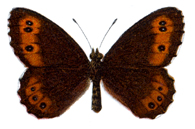
Erebia ligea Linnaeus, 1758 [Nymphalidae, Satyrinae]: a dark brown satyrine with a wingspan of 37–45 mm, distinguished by a narrow long white spot on the upper part of the hindwings. Fennoscandia across Asia to Japan; in C Europe only from 500–1,000 m.
*SpeakM 131; NabBut 589 (BE), 590 (BE)
& Ac: Erébia ligéa • En: Arran Brown • Fr: le moiré blanc fascié, le nègre, (Autres rivages) le Grand Nègre Hongrois • Ge: Milchfleck, Großer Mohrenfalter, Weißgesprenkelter Mohrenfalter • Ru: чернушка Лигия, белополосатая чернушка • Sp: erebia ligea
Erebia magdalena Strecker, 1880 [Nymphalidae, Satyrinae]: a Holarctic black or dark brown satyrine without any wing markings occurring on rockslides at high altitudes in the Rocky Mountains as well as in Alaska and Siberia. The type locality is given as "Colorado". Robert M. »Pyle identified the Black Butterfly at Longs Peak, Colorado, mentioned in a poem of Look at the Harlequins! as Erebia magdalena.
*StrOps 316; LHarl 171
& Ac: Erébia magdaléna • Am: Magdalena Alpine, Rockslide Alpine
Erebia manto Denis & Schiffermüller, 1775 [Nymphalidae, Satyrinae]: a ringlet, local in the Pyrenees, the Alps, the Tatra Mountains, the Carpathian Mountains and in Bosnia, from 1,200–2,500 m.
*NabBut 590 (BE), 591 (BE)
& Ac: Erébia mánto • En: Yellow-spotted Ringlet • Fr: le moiré variable, le petit nègre hongrois • Ge: Gelbgefleckter Mohrenfalter • Ru: чернушка Манто
Erebia (ex Marica) meolans de Prunner, 1798, syn stygne Ochsenheimer, 1807 [Nymphalidae, Satyrinae]: the Piedmont Ringlet, in C and N Spain, Massif Central, Alps, Apennines, from 600–2,300 m, mostly below 1,500.
*NabBut 591 (BE); Lep2 270
Erebia (ex Phorcys) mnestra Hübner, 1804 [Nymphalidae, Satyrinae]: Mnestra's Ringlet, in the C European Alps, from 1,500–2,600 m.
*NabBut 590 (BE), 592 (BE)
Erebia pandrose Borkhausen, 1788 [Nymphalidae, Satyrinae]: the Dewy Ringlet, in the Arctic and Alpine zones of Europe, Kola and Kanin Peninsulas, polar Urals, Altai, Mongolia, from 500–3,100 m. "The skipping, zigzagging flight of the species and those of the tyndarus group is quite different from other Erebias. The independent-looking motion and, in fresh specimens, underside bluish-grey flash of the hindwing are especially remarkable …"
*NabBut 590 (BE), 592 (BE)
& Ac: Erébia pandróse • En: Dewy Ringlet • Fr: le moiré cendré • Ge: Graubrauner Mohrenfalter
Erebia pluto de Prunner, 1798 [Nymphalidae, Satyrinae]: a velvety black European satyrine, relatively large (wingspan c. 43 mm), only in the Alps at altitudes from 1,600–3,200 m, preferring rocky terrain with sparse vegetation.
*SelLet 474; NabBut 590 (BE)
& Ac: Erébia plúto • En: Sooty Ringlet • Fr: le moiré velouté • Ge: Eismohrenfalter
Erebia (ex Syngea) pronoe Esper, 1780 [Nymphalidae, Satyrinae]: the Water Ringlet, on damp, grassy slopes often near brooks in the Pyrenees, the Alps and on Polish, Slovakian, Macedonian, Bulgarian and Macedonian mountains, from 900–2,800 m. "Ranges at elevations from 600 to 2600 ft. from the Caucasus and Turkey westward to the Pyrenees … Males, very abundant in limited areas (e.g., steep bank of a torrent) skipping all over the grass in search of females …"
*NabBut 591 (BE), 592 (BE)
Erebia rhodopensis Nicholl, 1900 [Nymphalidae, Satyrinae]: Nicholl's Ringlet, locally on Balkan mountains, described from the Rila Mountains in Bulgaria, at 1,800–2,600 m. "The only species of European butterfly described by a woman."
*NabBut 590 (BE), 592 (BE)
Erebia stygne: »Erebia meolans
Erebia theano ethela W.H. Edwards, 1891 [Nymphalidae]: Ethel's Alpine, a subspecies of the Theano Alpine in N and C America, from Arizona to Nicaragua.
*StrOps 323
Erebia triaria de Prunner, 1798, syn evias Godart, 1823 [Nymphalidae, Satyrinae]: de Prunner's Ringlet, in Spain, the Alps, Slovenia, Bosnia, Serbia, Albania, from 400–2,500 m.
*NabBut 590 (BE); Lep2 270
Ergane: »Pieris ergane
Erora laeta (Howe 1975)

*Erora laeta W.H. Edwards, 1862 [Lycaenidae, Theclinae]: this hairstreak without tails probably is the little butterfly which Nabokov, in a letter to Patricia Hunt of Life (Feb 6, 1951), described as "a perfect jewel (and one of the rarest butterflies in the world) of which only thirty or forty specimens have been taken since it was turned up by Edwards' Negro gardener almost a hundred years ago; at the present time two or three collectors know of a locality for it in Vermont, in early May – but the exact place is a secret." Its wingspan is only 20–25 mm. Above it is steel-blue with broad black margins, below bluish-green with white-rimmed reddish spots. The locality in Vermont Nabokov mentions is near Sherburne. Nabokov himself "looked for it near Brattleboro in 1942 and 1943". Alexander B. Klots wrote that laeta "is perhaps the greatest prize of northern collectors. It should be sought (and never expected) along rather shaded trails and 'woodroads' in Canadian Zone forest where Beech trees occur". Robert M. Pyle: "Few North American butterflies have attracted as much attention as this rare species, whose habits are shrouded in mystery … The Early Hairstreak may turn out to be far less rare than its reputation suggests once its behavior is fully known. Adults will alight on bare ground, at times remaining so still that they may be trod upon by the unwary. It is possible that Early Hairstreaks live high in the woodland canopy, descending within viewing range only occasionally." Males at least are known to perch on top of high trees in the afternoon waiting for females.
*SelLet 113; NabBut 448 (L), 497 (L), 498 (L)
& Ac: Eróra laeta • Am: Early Hairstreak, Turquoise Hairstreak
Eros Blue: »Polyommatus eros
Erynnis Schrank, 1801: Dusky Wings, a genus of »Hesperiidae (skippers), subfamily Pyrginae (pyrgine skippers). The type-species is »Erynnis tages. "Has been observed folded mothlike at rest, … a fitting position for the last genus of the butterfly list."
*Int1 126; NabBut 612 (BE)
Erynnis (ex Nisoniades) tages Linnaeus, 1758 [Hesperiidae]: the Dingy Skipper, in Europe to 62°N and across Asia to Amur region.
*NabBut 612 (BE); Lep1 29; Lep2 268
Esakiozephyrus bieti (Oberthür 1886)
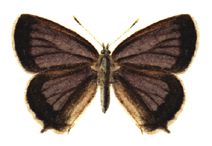
Esakiozephyrus bieti Oberthür, 1886 [Lycaenidae, Theclinae]: a hairstreak in C Asia and N India.
When Fyodor, in The Gift, dreams of going back to his former rented room in Berlin to meet his father who has returned from the dead, his dream depicts a ceiling painted with "Tibetan butterflies". One and only one of them is named, Thecla bieti. Boyd supposes this is an imaginary species discovered by Godunov Senior, but this is not so. It is real one, a small hairstreak with a wingspan of about 35 mm, later transferred to the genus Zephyrus Dalman, 1816 and today in Esakiozephyrus Shirôzu & Yamamoto, 1956. (The type-species of the genus is Esakiozephyrus icana Moore, 1875, the Dull Green Hairstreak of W Himalayas and W China.) The wings are brown in the female, with two bright blue marks and two or three orange dots, while in the male they have a metallic purple lustre and broad black margins. There is the rudimentary tail on the hindwings that has earned all the genus Thecla the German surname 'Zipfelfalter'. It flies from May to August in W China, Tibet, Bhutan and India, up to an altitude of 3,300 m. Thecla bieti has some resemblance to a common hairstreak of W Europe, Neozephyrus (ex Quercusia, Thecla) quercus Linnaeus, 1758, the Purple Hairstreak.
This is how its author, the French lepidopterist and lithographer Charles »Oberthür, described E. bieti in his series Etudes d'Entomologie, 11, 1886, p. 19–20: "Voisine de quercus, mais d'un bleu plus obscur en dessus et la bordure marginale beaucoup plus large. La f diffère du m de la même façon que dans quercus, c'est-à-dire par deux taches bleu brillant et deux ou trois points orangés aux ailes supérieures. La frange est brun jaunâtre ... J'ai dédié cette Thecla à Mgr Biet qui l'a capturée à Tâ-Tsien-Loû."
Though bieti and, still more, T. bieti look suspiciously like anagrams of "Tibet", the origin of the name is a different one. Oberthür conferred it at least seven times to honor "Sa Grandeur Monseigneur Félix »Biet" (1838–1901), Bishop of Diana, Apostolic Vicar in Tibet, one of the Roman-Catholic missionaries from France who provided him with a steady supply of undescribed Lepidoptera collected by himself and by his co-workers and helpers. It was a French missionary who in 1917 was the last one to see Godunov Senior alive, in the mountains of Tibet, near the village of Chetu. As Biet went to Tibet in 1864 and returned to France in 1891, neither he nor Father »Dejean (mentioned in The Aurelian) can be the missionaries who last saw Godunov Senior. "Chetu" is what the British explorer-lepist John Henry »Leech spelled Che-tou, a hamlet about ten miles southwest of Tatsienlu, on the old caravan trail from the Sechuan basin to the Tibetan Plateau. According to Leech, Thecla bieti had been found in "Che-tou, Ta-chien-lu, Moupin and How-kow". This is how Leech describes Che-tou in his Butterflies from China, Japan, and Corea (1892–4, p. xxviii): "A group of Thibetan hamlets situate one day's journey S.W. from Ta-chien-lu. The mountains are covered, in parts, with grass and an abundance of flowers. There are pine-forests in the deep valleys." Fyodor may be metamorphosing the blue tulips on a yellow background which the wallpaper in his room had sported into Tibetan butterflies on the ceiling and swans and lilies on the walls. His dream logic is connecting his father's death, Thecla bieti, Che-tou and French missionaries to Tibet. One of the sources for this connection may be Leech's work, another Oberthür's OD of Thecla bieti, contained in an article titled "Espèces nouvelles de lépidoptères du Thibet". There he had gratefully acknowledged the French missionaries' work in Tibet: "Déjà j'ai écrit toute mon admiration pour ces hommes d'élite qui au milieu des plus rudes labeurs, dans un isolement auquel succomberait les caractères les plus fortement trempés, trouvent assez de force pour s'intéresser aux sciences naturelles, alors même qu'ils sont au prises avec le périls et les dangers de l'heure présente. Les circonstances actuelles, particulièrement difficiles pour les Missions catholiques de Chine, nous rendent encore plus chers ces prêtres ..." (p. xii).
Nabokov's main source, however, very probably was neither Oberthür nor Leech but the British naturalist and explorer A. E. »Pratt's book To the Snows of Tibet through China (London 1892). Pratt had gone up the Yangzi and Min Rivers and reached the region of Tatsienlu in July, 1889, returning again in April, 1890. He there met Bishop Biet, Father Dejean and other French missionaries to Tibet and received much hospitality and help from them. On July 25, Pratt went to "Chet-tu" for four days, "a Tibetan village about ten miles to the westward … This district is rich in Thecla, and I have taken as many as 300 T. bieti in one morning with my forceps off the droppings of the baggage animals on the Lhassa road" (p. 144–145). Thecla bieti is one of only three or four butterflies explicitly named in Pratt's book. Leech had not been to Tatsienlu himself but relied on Pratt's account and photographs when he analyzed the butterflies Pratt had brought home from his expedition. The multitude of bieti in Pratt's account seems to have made Fyodor's dream populate the whole ceiling with them.
|
French missionaries in Tatsienlu: front left Bishop Biet, rear left Father Dejean (Bonvalot 1891) |
Pratt and coworker (Kricheldorff?) camping near Tatsienlu (Pratt 1892) |
|
|
|
The region around Tatsienlu clearly was a focal place for Nabokov's imagination. The place name has a famous ring in 19th century biology. It is the type locality of many exotic new species of insects, birds, mammals and rhododendrons. This is not because the place itself was so abundant in species unknown to science but because it was the center of a vast mountain region with much biodiversity that had hardly been explored before, where collecting was extremely good and where there were missionaries to forward the specimens collected to Europe.
In their book Nabokov's Blues (1999, p. 313–314), Kurt Johnson and Steve Coates claim that Oberthür and hence Nabokov, Fyodor and Pilgram (the hero of The Aurelian) who so much envies Father Dejean ("stout-hearted missionary climbing among the rhododendrons and snows", just like Pratt did) were wrong when they placed Tatsienlu in Tibet. According to Johnson, it was sheer imagination when Nabokov peopled its "crooked, narrow streets" with "shaven lamas … spreading the rumor I was catching children in order to brew their eyes into a potion for the belly of my Kodak". When continuing Leech's scientific work on Pratt's lycaenids in 1991, Johnson says, he discovered that Tatsienlu was not in Tibet at all but a "small village … four hundred miles from the Tibetan border on the Yunnan Plateau, on the border between Sichuan and Yunnan Provinces in western China … The village sits at an altitude of about nine thousand feet, and its site is a far cry from the high-altitude Tibetan plateau, barren and snow-strewn, upon which Nabokov's fiction placed it."
A far cry it may be, but Nabokov's literary imagination had not misplaced Tatsienlu in the least, neither geographically nor biogeographically. It is Johnson who misplaces it by putting it on the Yunnan Plateau. Tatsienlu is not a "small village" either but an old crossroads town and today the administrative capital of Ganzi (or Garze) Tibetan Autonomous Prefecture in the SW Chinese province of Sechuan. The distance to the border of Tibet proper (i.e., the Tibetan Autonomous Republic, or TAR) which here runs along the Upper Yangzi is 165 miles as the crow flies, and 450 up the arduous winding high road towards Lhasa. Its name (which means Arrow Forge) has been changed to Kangding (Hanyu Pinyin spelling) in 1913; its Tibetan names are Dartsendo or Dardo. Its population is about 25,000 and was about 20,000 at the turn of the 20th century. One contemporary visitor describes it as "a surprisingly dense metropolis squeezed between high valley walls". It was and still is an important trading post on the only high road from Sechuan to Tibet proper. The Comprehensive Geography of the Chinese Empire and Dependencies (c. 1907) says, "The town is largely Tibetan, and carries on an important trade in musk, wool, gold, furs, medicine, bristles and yak tails, all coming from Tibet. It exports thither chiefly (brick) tea, and also silks and cotton goods". Its population was and is mixed Chinese and Tibetan, the predominant element being Tibetan. One contemporary Chinese visitor writes: "The first impression Kangding gave me was—the Tibetans own this place." An old encyclopedia (1928) says that among its Tibetan population there were 4,000 to 5,000 lamas. Pratt in 1889 found its streets "crowded with a strange mixture of races. The houses are certainly Chinese, but the population is a mixture of all the nations of Asia, Tibetans predominating … Many lamas are seen at all times in the town, there being a large lamasery just outside. They may be told by their scarlet cloaks and shaven heads, and their music while at prayers is heard all day long" (p. 133, 139). A photograph by Pratt (also reproduced in Leech's book) shows its situation between high mountains and its crooked streets about which Pratt says: "The city of Ta-tsien-lu is most irregularly built, the houses being of all shapes and sizes, the roadways merely layers of large stones …" (p. 138).
|
A street in Tatsienlu (Pratt 1892) |
Entrance to the valley of Tatsienlu (Bonvalot 1891) |
|
|
|
About Tatsienlu being situated in Tibet or in China, Leech says, "A good deal of uncertainty exists concerning the exact boundary lines of Western China and Thibet; but it is quite certain that all the localities visited by Pratt, A. Kricheldorff [who was to become an insect dealer in Berlin] and their collectors are situated in China proper. How-kow, which I previously considered to be in Thibet, is said to be on the borderline. Mons. Oberthür has erroneously referred Ta-chien-lu and its neighbourhood, and also Mou-pin, to Thibet instead of China" (p. xxix). Johnson's discovery thus only echoes Leech's remark.
Pratt who had been there believed to have reached Tibet, and Oberthür was not that mistaken when he wrote 'Tibet' or 'East Tibet,' and he had not been naive about it either, recognizing that politically the region was claimed by China. Historically, Tatsienlu/Dartsendo was in Kham, one of the three regions traditionally considered Tibetan ethnically, culturally and linguistically, the others being Amdo in the north and U-Tsang in the west. Only U-Tsang has become the Tibetan Autonomous Republic, or Tibet proper, after the Chinese occupation in 1950. That is, Tatsienlu was situated in the disputed Tibetan-Chinese border region. For the traveler going from the Sechuan basin to the Tibetan Plateau, it was the first Tibetan town, for the traveler coming from Lhasa and going to Sechuan, it was the first Chinese one. China had exercised a sort of more or less ineffectual suzerainty over all of secluded Tibet for centuries, appointing residents in Lhasa who shared the power with the Dalai Lama, more or less controlling the roads and levying taxes on some of the more susceptible Tibetan tribes. However, they largely respected the autonomy of the local Tibetan populations. When in 1726 China pushed its western border into Kham to the Upper Yangzi, just west of Dartsendo/Tatsienlu, it was content with establishing Chinese settlements along the main trade roads, leaving the rural villages completely Tibetan and a mix of Tibetan and Han Chinese in trading posts like Tatsienlu. The French missionaries Huc and Gabet who passed through in 1846 write, "This area has passed to and fro between the Tibetans and the Chinese; for the last century it has been integrated into the empire". (Lamas of the Western Heavens, 1851-1854, Folio Society, 1982) However, a historical map for the years 1940-1950 (!) still shows the town in a fuzzy border region "controlled by Tibetan chieftains and Chinese Military". Ganzi Tibetan Autonomous Prefecture was fully incorporated into the province of Sechuan only in 1956. It is still considered one of the "wildest" (that is least Han Chinese) regions of China. So 19th century residents like Biet or his correspondent Oberthür were quite correct in saying that Tatsienlu was in Tibet or East Tibet. Lhasa and U-Tsang being closed to foreigners, East Tibet was about the only place a missionary who wanted to christianize Tibetans could go to. As Pratt attests, even there he was bound to encounter much hostility from lamas and mandarins, from Tibetan and Chinese folks alike, putting his life at a constant risk. All the selfless efforts of the missionaries did not win them any Christian believers among Tibetans and only a few among the Han Chinese.
Nabokov did not misplace Tatsienlu biogeographically either. The town is built along a roaring river in a narrow valley of the Daxue Shan (Snowy Mountains) at an elevation of 2,550m, at the foot of several high mountains the highest of which is the Gongga Shan towering up to 7,556m. The wider surroundings are mountainous woodland and grassland, described by a present-day traveler as "a stupendous mix of lush valleys, alpine pasture, and frigid, snowy heights". Nabokov nowhere claimed that the town was on the "barren and snow-strewn" high-altitude Tibetan Plateau. He could not, his main source being Pratt's first-hand account to which he owes all the details he gives. Following Pratt, he correctly placed it "on the slopes of a snowy range, which were drowned in the rich, rosy foam of great rhododendrons" and with "pines draped in lacy lichen". Pratt on the snowy mountains, rhododendrons and pines of Tatsienlu: "The scenery was magnificent … Views up ravines disclosed snow-capped mountains, below which were forests of dark pine … Just below the snow, grass was growing, and then in rotation followed pine forests, rhododendrons, mixed evergreens, and then in valleys sub-tropical plants" (p. 132). "… rhododendrons grew in the greatest abundance and of large size, many stems being over a foot in diameter" (p. 178). "… a valley, the sides of which could be seen for miles down covered with rhododendrons in blossom of all shades of white, pink, and red – a perfect sea in bloom … The mountains were covered where possible by pine forests; but the surface was very rocky …" (p. 181–182). "Near by was a small lake, the banks of which were clothed in rhododendrons. The pine trees round had a beautiful lichen growing on them of a pea-green colour, which hung from the limbs and branches in graceful festoons" (p. 188).
Johnson also errs as to the climate of Tatsienlu, calling it "one of the most hospitable climates in the world, famous for its mild temperatures and brilliant blue skies dotted for a great part of the year with fair-weather cumulus clouds". That is true of the Yunnan Plateau 350 miles to the south, known as a "region of eternal spring". Tatsienlu on the other hand has one of the less hospitable climates of the world, with cold and long winters lasting until June, brief summers and much summer rain. The British explorer Capt. Bower who passed through in 1892 said of its climate, "In addition to being an unhealthy climate, it is also a very disagreeable one – damp, cold, and windy; when it is not raining it is snowing; altogether a most depressing place" (Hamilton Bower, Diary of a Journey Across Tibet, New York 1894, p.244).
Pratt's book clearly shows why Tatsienlu was such a tempting and such a dangerous place for a European naturalist like Fyodor's father.
See also »Hepialus armoricanus.
The holotype of one of the taxa described by Nabokov, the skipper »Carterocephalus canopunctatus, is also from Tatsienlu.
*Stor:Aur 249, Gift 122, 354
& Ac: Esakiozéphyrus/Thécla biéti • En: Indian Purple Hairstreak
& Ac: Neozéphyrus/Quercúsia quércus • En: Purple Hairstreak • Fr: le thécla du chêne • Ge: Blauer Eichenzipfelfalter • It: tecla della quercia • Ru: дубовая хвостатка • Sp: nazarena
Geometra papilionaria (Hübner 1793-1827)

Esmeralda: Though by no means certain, the Esmeralda of Nabokov's 1953 poem "Lines Written in Oregon" ("Where the woods get ever dimmer, / Where the Phantom Orchids glimmer – Esmeralda, immer, immer") might be an allusion to a lepidopteron. In the same poem there is a "peacock moth on picnic table".
There are four of this name: (1) The owlet moth Polychrysia esmeralda Oberthür 1880 [Noctuidae, Plusiinae], a rare night-flying moth with a wingspan of about 36 mm, in Estonia, C and E Asia and China. (2) Chlororelas esmeralda Butler 1886 [Lycaenidae], a local SE African hairstreak. (3) Ino tristis esmeralda Butler 1877 [Zygaenidae], a burnet moth confined to Japan. (4) Cithaerias esmeralda Doubleday 1845, a satyrine from Brazil and Peru. The wings are transparent (span 50 mm) and have an eyespot and a purple patch on the hindwing. H.W. »Bates was very fond of it: "One of these clear wings is especially beautiful, namely, the Hetaira Esmeralda; it has one spot of opaque coloring on its wings, which is of a violet and rose hue; this is the only part visible when the insect is flying low over dead leaves in the gloomy shades where alone it is found, and then it looks like a wandering petal of a flower" (The Naturalist on the River Amazons, 1864, p. 63).
None of these butterflies and moths is likely to ever appear in Oregon, and none is anything like a peacock moth. Robert Michael Pyle, however, has found a Plusia (= Polychrysia) esmeralda in McDunnough's checklist of N American moths. (I have found no confirmation that it actually flies in Oregon.) He believes Nabokov's "discovery" of »Autographa excelsa in his Russian childhood may have made him yearn for a related moth in America (Nabokov's Butterflies, p. 73–74).
To me, Bates' decription of Cithaerias esmeralda at least sounds as if Nabokov might have wished this hetaera to appear there. But it could also be that in this poem fusing the mountain forests of the American West with those of medieval Europe, Esmeralda on the one hand is the beautiful, brave and unfortunate gypsy girl of Victor Hugo's novel Notre Dame de Paris, certainly a childhood memory; and that, thinking of those days, Nabokov also thinks of one of the European insects of his youth connected to her by its very name, the Large Emerald (»Geometra papilionaria) mentioned in Speak, Memory.
*P&P 172
Euchloe Hübner, 1819: a genus of »Pieridae, subfamily Pierinae, usually white dappled with black, brown or greenish. The type-species is Euchloe ausonia Hübner, 1803 var. esperi Kirby 1871, the Eastern Dappled White.
*NabBut 270 (L); LtVé 475
Euchloe ausonia, female (Lewington 1997)
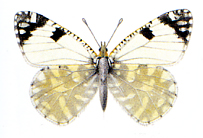
Euchloe ausonia Hübner, 1803 [Pieridae]: a dappled white, in N Africa, the Iberian peninsula, C and S Italy, S Balkans, Near East, Middle East to S Kazakhstan, Tibet and Amur region, with a wingspan of 36 to 48 mm. The nominal subspecies Euchloe ausonia ausonia was described from Italy.
*NabBut 586–7 (BE); LtVé 508
& Ac: Éuchloë ausónia • En: Eastern Dappled White, Pearl White • Fr: le Marbré oriental • Ge: Östlicher Gesprenkelter Weißling Falter • Ru: бледно-пятнистая белянка, Зорька белая
Euchloe ausonia volgensis Krulikovsky, 1897, syn var. uralensis Bartel, 1902 [Pieridae]: in his first butterfly paper Nabokov mentions he found "Euchloe belia var. uralensis" in the Crimea. "This is a common butterfly in the parks and gardens of the coast." As belia, the Morocco Orange-tip (which today is in the genus Anthocharis) does not occur in S Russia, and as there is no variety by the name uralensis on record, he must have confused it with a related butterfly, »Euchloe ausonia, the Eastern Dappled White, having a variety by the name uralensis, a junior synonym of volgensis.
*Lep1 31
Euchloe simplonia Boisduval, 1828 [Pieridae]: the Mountain Dappled White, from N Spain, French Alps, SW Switzerland and NW Italy. Some authors consider it a subspecies of »Euchloe ausonia, the Eastern Dappled White. It was described from France; a year later, Freyer seems to have described it from Croatia.
*NabBut 586–7 (BE)
Euchrysops Butler, 1900: an African genus of »Lycaenidae, subfamily Polyommatinae (blues), tribe Polyommatini, Euchrysops Section. The type-species is Euchrysops cnejus Fabricius, 1798, the Gram Blue.
*Lep9 19, 46
Euclidia glyphica (not gryphica) Linnaeus, 1758 [Noctuidae, Catocalinae]: a European owlet moth.
*Lep2 268
& Ac: Euclídia glýphica • En: Burnet Companion • Fr: la doublure jaune • Ge: Braune Tageule • Ru: ленточница узорчатая
Eugenia onegini: an imaginary butterfly Nabokov drew for his wife on the front end paper of Conclusive Evidence on January 23, 1951. The editors explain, "With this silver-green iridescence on its upper wings, the butterfly resembles the large-winged African Brushfoot genus Panacea … Pushkin himself had African blood, by his grandfather, Abram Gannibal …"
*Véra's Butterflies, p.149; NabBut plate 8
Eugonia xanthomelas: »Nymphalis xanthomelas
Eugonia polychloros: »Nymphalis polychloros
Eumedonia Forster, 1938: an abandoned genus of »Lycaenidae, subfamily Polyommatinae (blues). The type-species was Eumedonia eumedon Esper, 1780, the Geranium Argus, in Europe, Turkey, Urals, Mongolia, Altai and Tianshan. In 1997, Bálint & Johnson collapsed Eumedonia into the genus »Aricia Nabokov 1945. See also under »Lycaenidae and »Polyommatus Section.
*Lep9 33, 48
Euphilotes (ex Scolitantides) battoides Behr, 1867 [Lycaenidae, Polyommatinae, Polyommatini, Glaucopsyche Section]: the Buckwheat Blue (or Square-spotted Blue), in the Sierra Nevada of California. The types were destroyed in the San Francisco earthquake of 1906.
*StrOps 320; NabBut 465 (L)
Euphilotes (ex Philotes) enoptes Boisduval, 1852 [Lycaenidae, Polyommatinae, Polyommatini, Glaucopsyche Section]: the Dotted Blue, in the entire W of the United States.
*NabBut 465 (L); Lep16
Euphydryas Scudder, 1872: a Holarctic genus of »Nymphalidae, subfamily Nymphalinae, tribe Melitaeini (checkerspots). The type-species is »Euphydryas phaeton Drury, 1773, the Baltimore.
Euphydras anicia howlandi (Howe 1975)
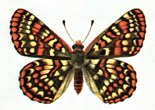
Euphydryas (ex Occidryas, Melitaea) anicia Doubleday & Hewitson, 1848 [Nymphalidae]: the Anicia or Paintbrush Checkerspot, in the west of N America, from Alaska to Mexico. "This is a beauty." Orange with black and yellow spot bands above, wingspan 28–48mm.
*Int1 126 (NabBut 531); Lep16
Euphydryas (ex Melitaea) aurinia Rottemburg, 1775 [Nymphalidae]: the Marsh Fritillary, in Morocco, Algeria, most of Europe, temperate Asia, Korea.
*NabBut 623 (L); Lep2 269
Euphydryas aurinia debilis Oberthür, 1909, hom merope de Prunner, 1798, glaciegenita Verity, 1928 [Nymphalidae]: a subspecies of the Marsh Fritillary, in the Alps and Pyrenees, mostly above 1,800 m. The form glaciegenita, restricted to high altitudes in the C Alps, was synonymized under debilis.
*NabBut 600–1 (BE), 623 (L)
Euphydryas aurinia provincialis Boisduval, 1828 [Nymphalidae]: a subspecies of the Marsh Fritillary, from SE France and N Italy, at 300–1,000 m.
*NabBut 601 (BE)
Euphydryas (ex Hypodryas) gilletti(i) Barnes, 1897 [Nymphalidae]: Gillette's Checkerspot, in the mountains of Montana, N Idaho and Alberta.
*Lep16
Euphydryas maturna: »Hypodryas maturna
Euphydryas phaeton Drury, 1773 [Nymphalidae]: the Baltimore (Checkerspot), in wet meadows or hillsides from S Canada to Georgia and Missouri.
*NabBut 398 (L)
Eupithecia linariata (Lampert 1907)
![]()
Eupithecia Curtis, 1825: a large genus of Holarctic »Geometridae, subfamily Larentiinae. They are small with elongated forewings, mottled with gray and white or brown and green. The type-species is Eupithecia centaureata Denis & Schiffermüller, 1775, the Lime-speck Pug.
In an interview with Gerald Clarke for Esquire (1975), Nabokov mentioned that as a boy he had dreamed of one day writing a monograph on "The Eupithecia of the World". Given the number of pugs (several hundred) and their reputation of being extremely hard to distinguish, it would have been an especially arduous task.
*Lep2 257
& Ac: Eupithécia • En: pugs, pug moths • Fr: eupithécies • Gr: Blütenspanner • Ru: цветочная пяденица, (Nabokov) «евпитеций», оконце мадонны • Sp: eupitecia
Eupithecia nabokovi McDunnough, 1945 [Geometridae]: see in »Section 1.
*SpeakM 126; StrOps 187; NabBut 469 (L)
& Ac: Eupithécia nabókovi • En: Nabokov's Pug • Ge: *Nabokov's Blütenspanner
'Eupithecia petropolitanata' Nabokov [Geometridae]: see under »Eupithecia nabokovi McDunnough, 1945.
*SpeakM 136
Eupithecia pumilata: »Gymnoscelis rufifasciata
Euplagia (ex Panaxia) quadripunctaria Poda, 1761 [Arctiidae or Noctuidae Arctiinae]: a day-flying tiger-moth with a wingspan of 50 to 55 mm. It is found all over Europe except for Norway, Sweden, the Baltic States and N Russia.
& En: Jersey Tiger Moth • Fr: Écaille chinée • Ge: Russischer Bär • Ru: Медведнца четырехточечная
*Dmitri Nabokov, "On Revisiting Father's Room", Encounter, Oct 1979, p.77
Euptoieta claudia Cramer, 1775 [Nymphalidae, Heliconiinae, Argynnini]: the Variegated Fritillary, ranging from the S United States through the West Indies to Argentina.
*StrOps 327
Eurema lisa (Howe 1975)

*Eurema lisa Boisduval & LeConte, 1829 [Pieridae, Coliadinae]: one of the small sulphurs of the genus Eurema Hübner, 1819 whose type-species is Eurema daira Godart, 1819, the Barred Yellow. They all are of small to medium size (wingspan 28–38 mm), with yellow, orange or white as the ground color and maroon or black outer margins.
In Pale Fire, there is "that vortex of yellow and maroon butterflies that so pleased Chateaubriand on his arrival in America". They probably were Eurema butterflies. One can even say which species. William H. Howe in The Butterflies of North America (1975, p. 371): "Despite their small size and delicate appearance, some of these butterflies are capable of long sustained flight and periodically engage in tremendous migrations containing millions of individuals. Huge squadrons of Eurema lisa have been reported in flight both over land and far at sea. These migrations predate history in the New World and it was probably a swarm of either Eurema lisa or Phoebis eubule that Columbus and his crew saw about the Santa Maria near the south coast of Cuba." As »Phoebis sennae eubule has no maroon, the vortex of butterflies Chateaubriand saw on his arrival in America's will probably have been Eurema lisa. Nabokov saw it in Wellesley, Massachusetts, in the warm fall of 1946.
*PaleF 247; Lep11 42
Eurema mexicana Boisduval, 1836 [Pieridae, Coliadinae]: the Mexican Yellow, in Mexico, C America and S America.
*StrOps 328
Eurema nicippe Cramer, 1779 [Pieridae, Coliadinae]: the Sleepy Orange, from Costa Rica and West Indies to New York and Colorado.
*Lep11
Eurythemia: this, in "Father's Butterflies", is said to be an "Asiatic genus" (of what?) with four species, each of which has developed "four of the sixteen traits characterizing the appearance of the genus, namely one for the four traits of pattern, one of the four traits of foot structure, one of the four genital traits, and one of the four traits of venation". There is no genus of this name. The closest in spelling is Eurythmia Ragonot, 1887, an American (not Asiatic) genus of snout moths (Pyralidae), a family of small to medium sized, plainly colored, slender-bodied and long-legged moths. There were indeed four species after the type-species ignidorsella Ragonot, 1887 had been transferred to the genus Eurythmidia Hampson, 1901: angulella Ely, 1910, furnella Ely, 1910, spaldingella Dyar, 1905 and yapavella Dyar, 1906.
*NabBut 231–232 (FB)
Eurytides marcellus (Seitz 1924)
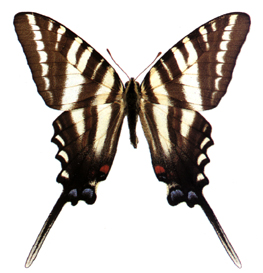
Eurytides (ex Graphium, now Protographium) marcellus Cramer, 1777 [Papilionidae]: the commonest of N American kite swallowtails. Its range is from New England to the Gulf States. It is superficially quite similar to the Scarce Swallowtail of Europe (»Iphiclides podalirius), though it is narrower and the color of its upper side is "chalk-white to hint of blue-green with black stripes and bands" (Robert M. Pyle) while the basic color of Europe's Scarce Swallowtail tends to be yellow, from a pale to a quite pronounced one.
*StrOps 169, 327
& Ac: Eurýtides marcéllus Am: Zebra Swallowtail (for Nabokov's use of "Zebra Swallowtail" for its European counterpart, see »Iphiclides podalirius)
Everes Hübner, 1819: a genus of »Lycaenidae, subfamily Polyommatinae (blues), tribe Polyommatini, Everes Section. The type-species is »Everes argiades, the Short-tailed Blue.
*NabBut 575 (BE); Lep9 3, 5
Everes alcetas Hoffmannsegg, 1804 [Lycaenidae], the Provençal Short-tailed Blue, in Spain, S Europe, Balkans, Turkey, Urals, S Siberia, Altai.
*Lep2 269
Everes argiades Pallas, 1771, syn amyntas Denis & Schiffermüller, 1775 [Lycaenidae], a small blue (wingspan 20–27 mm), in N Spain, S, C and E Europe, Asia and Japan.
*Lep2 268, 270
& Ac: Éveres argíades • En: Short-tailed Blue • Fr: l'azuré du trèfle • Ge: Kleebläuling • Ru: голубянка Аргиадес • Sp: naranjitas rabicorta
Everes (ex Lycaena) comyntas Godart, 1814 [Lycaenidae]: the Eastern Tailed Blue, in S Canada, Rocky Mountains, Midwest south to Costa Rica.
*N/WLet #66= 55old; NabBut 398 (L)
Everes (ex Lycaena) decoloratus Staudinger, 1886, syn sebrus Hübner, 1824 [Lycaenidae]: the Eastern Short-tailed Blue, in SE Europe.
*Lep2 269
Everinae: a former subfamily of »Lycaenidae, constructed around the genus »Everes Hübner, 1819. Today it belongs in the subfamily Polyommatinae.
*NabBut 302
Everini Tutt, 1907: a tribe of »Lycaenidae, constructed around the Holarctic genus »Everes Hübner, 1819. In Eliot's classification of 1973, they would be the Everes Section of the tribe Polyommatini within the subfamily Polyommatinae.
*Lep9 3
Eversmann's Orange Tip: »Microzegris pyrothoe
Exereta (not Exaeretia) ulmi: »Dicranura ulmi
*Eyed Hawk Moth: »Smerinthus ocellatus
